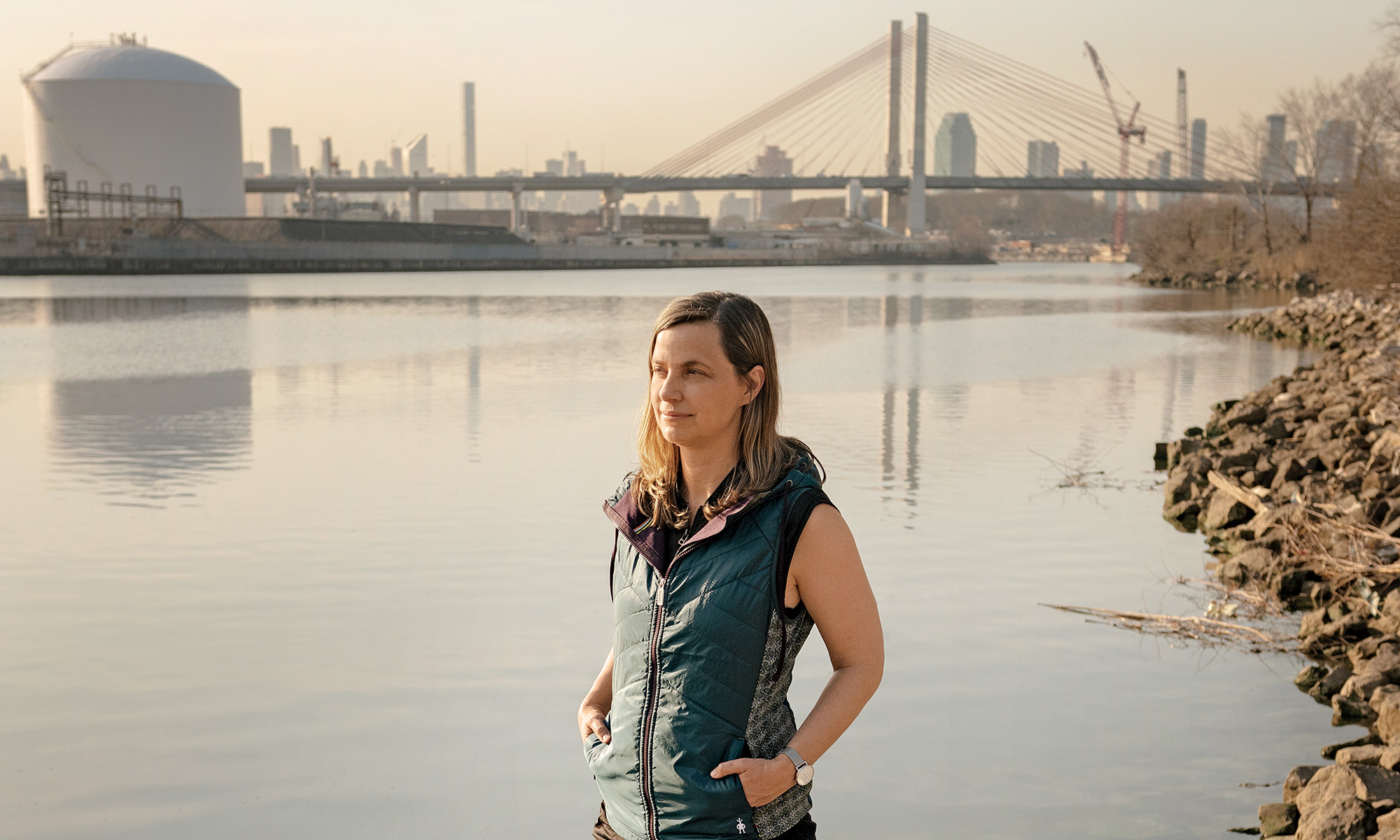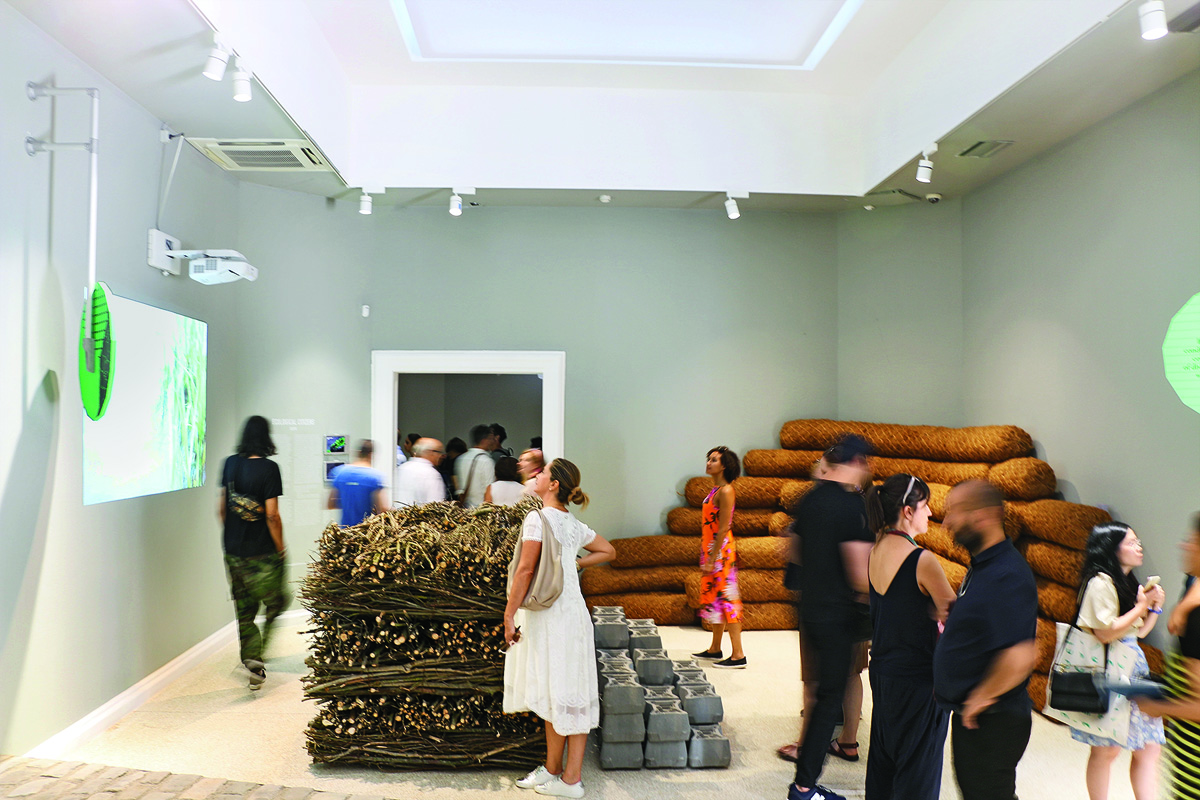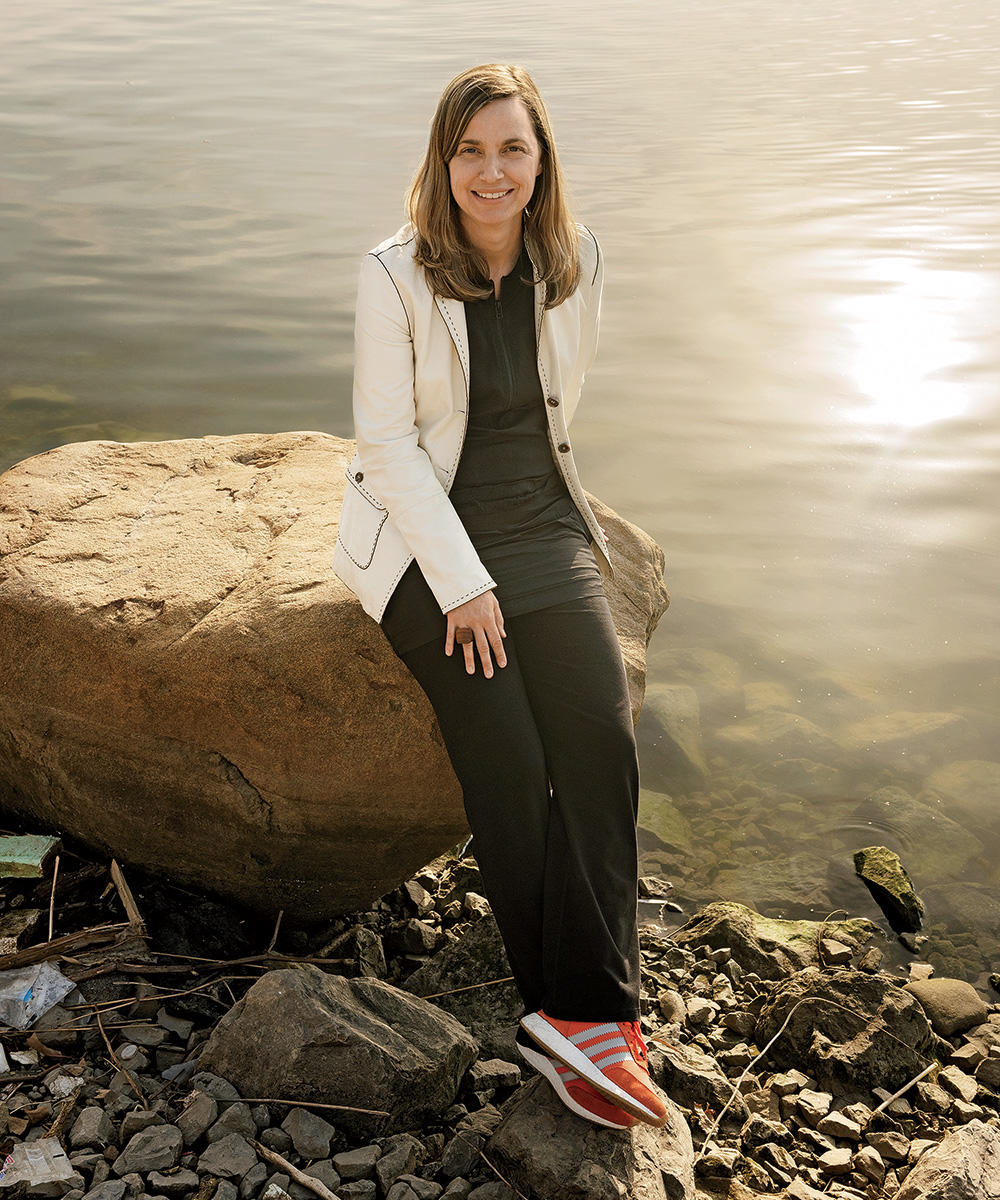
Looking out from the Manhattan shoreline at New York City’s rivers and sounds, toward the double harbor, with its great watery foyer and complicated inner chambers, to the Narrows and the ocean beyond, our eyes see little of what’s really there. The gaze glides across the steely, undifferentiated plane of water, pausing only when it reaches another urban shore: the lowlands of Red Hook, crowned by gantries, the hunched mass of Staten Island, the hardened podium of Liberty Island, the high-rises of Jersey City. But when Kate Orff scans the same geography, she registers the vista over multiple eons. Peering into the past, she sees a rocky subaqueous terrain full of ridges, vales, reefs, and channels. The present is flatter, and the future … well, in the future all those landmarks just above the waterline may well be gone.
Orff is a landscape architect, though she might more accurately be described as a waterscape interventionist. She works at the juncture of city and sea, the fragile intertidal zone that urbanization has threatened and that is now, in turn, threatening cities by fading away. Along this damaged shoreline, concrete imprisons wetlands, effluent wipes out entire ecosystems, and river sediment gets swept out to sea without being replenished. The ancient waterscape encircling New York has been smoothing itself out for a century or more.
Orff has set herself the impossible task of restoring this lost topography, along with its oysters, horseshoe crabs, and finfish. Her mission is rooted in her belief that landscape design is regenerative, that it can reshape the natural world to make the built environment safer, saner, and more sustainable. By restoring natural ecosystems, we can help protect an endangered metropolis. Underwater crannies and barrier islands can shatter waves, mitigating the violence of storms. Oyster reefs can clean polluted bays. Marshes can sponge up floodwaters and release them over time, heading off currents that might otherwise go churning down the streets of, say, Lower Manhattan, to fill basements and subway tunnels.
An associate professor at Columbia’s Graduate School of Architecture, Planning, and Preservation (GSAPP) and a 2017 MacArthur Fellow, Orff, forty-seven, embodies the environmental conscience of the design profession. As the founder of SCAPE studio, she puts global theories into practice at a manageable scale: restoring a small city park, a stretch of New York coastline. As the director of GSAPP’s Urban Design Program, she is trying to terraform a whole institution, recruiting Columbia’s lawyers, engineers, climate scientists, sociologists, economists, and policy experts to help solve our environmental challenges when they can, as quickly as they can.
Not content to holler about baleful trends, Orff is ready to fight them. Her favorite projects involve the communal labor of fixing up the shoreline, rock by rock, root by root, reef by reef. It’s unglamorous work, requiring patience and an appetite for uncertainty. Unlike a building, a work of landscape architecture generally opens when it’s still immature, bare, and vulnerable to erosion. It evolves over time, not always predictably. When an architect designs a skyscraper, developers can foresee the result, schedule a ribbon-cutting for politicians and the press, and then measure the building’s success in dollars. By contrast, Orff’s current endeavor, Living Breakwaters, a seventy-four-million-dollar pilot project to construct a set of artificial reefs off the southern tip of Staten Island, is a long-term initiative to build what she calls “a calmer, safer, more productive relationship with water.” Orff plans to lay down fingers of concrete riddled with nooks and niches, essentially an underwater metropolis for a new population of oysters, horseshoe crabs, migrating birds, eelgrass, and rock-loving fish. The hope is that these teeming barriers will dampen the assault of storm-pushed waves and at the same time prime the natural cycle that can rebuild the eroded beach. Will the tides cooperate? Will the community embrace the responsibilities of stewardship? Will the next phase get funded? Maybe.
Orff’s first serious explorations of landscape and ecology within the field of architecture came in 2010, when her Columbia colleague Barry Bergdoll ’77CC, ’86GSAS, then chief architecture curator at the Museum of Modern Art, tapped her to participate in a 2010 show called Rising Currents. Bergdoll wanted the exhibition “to jump-start a dialogue on the urgency of climate change and rising sea levels among public officials, policymakers, and the general public.” Orff reached back to her childhood summers on the Chesapeake Bay and came up with the idea of putting oysters to work in the waters of Brooklyn’s famously filthy Gowanus Canal. These industrious little bivalves scrub pollutants from water, and in a project she titled Oyster-tecture, Orff envisioned cultivating the creatures in New York’s most fetid channel, then seeding harbor reefs, and eventually preparing the way for the return of sidewalk vendors shucking the local catch. Some of the show’s reviewers were doubtful. “Because the contributors to this show are young and relatively untested … there are some slightly hokey elements,” wrote the Times’ architecture critic.
The Rising Currents proposals seemed a lot less whimsical after Superstorm Sandy muscled into New York in 2012. MoMA’s exhibition looked suddenly prescient, and so did Orff’s mollusk-centered proposal. Largely thanks to Rebuild by Design, a federally funded program launched by the Obama administration to help protect coastal communities from nature’s increasing violence, Orff’s project was, as she says, “pushed through an engineering sieve.” One result was Living Breakwaters, the Staten Island experiment. Orff thinks of that project not as a culmination but as a toehold in the fight to protect cities from climate change.
Orff grew up in the once-gated suburb of Crofton, Maryland, where she could roam free across an estate bounded by three major roads. Though she spent some weekends sailing along the salt marshes of the Chesapeake Bay, hers was not an especially pastoral childhood. Her closest encounters with nature came tending the box turtle she kept on her porch and working summer jobs at a local garden store. “I wasn’t out walking through a field overcome by the sublime landscape,” she says. “It was pretty prosaic.”
She attended the University of Virginia with vague ideas about becoming an artist, then gravitated to the interdisciplinary program in political and social thought. An energetic undergraduate with clearer ideas about how to reshape society than how to organize her life, she tossed an assortment of interests — anthropology, women’s studies, radical politics, environmental science, sculpture — into an ad hoc curriculum and wrote a senior thesis on ecofeminism. Somehow she wound up in a course on landscape architecture taught by Reuben Rainey ’71GSAS, cofounder of the UVA architecture school’s Center for Design and Health.
“At first it felt like an art-history class — ‘Oh, here’s a nice garden in Italy!’ — but by the end I understood that this isn’t just history; it’s a contemporary profession that actual people do.”
That slow-mo epiphany propelled Orff to Harvard’s Graduate School of Design in the mid-1990s. There she met Rem Koolhaas, the Dutch Yoda of architecture who has achieved global celebrity dispensing gnomic wisdom and developing outlandish designs that sometimes even get built. He took Orff and a small group of students to study the Pearl River Delta in China, one of the world’s most complex urbanized ecosystems. Under Koolhaas’s tutelage, she internalized the idea of the land as a restless, dynamic thing, and twenty years later she still treasures her teacher’s praise: “Rem said to me: ‘You’re like landscape itself: fluid, moving, and adaptive.’” She agrees. “I like to take an experience and push it in new directions. I have no fear or anxiety.”
Her professed unflappability is occasionally undermined by her obvious sense of emergency. From time to time, Orff starts talking with a throaty urgency, as if she has so many thoughts that she can’t possibly fit them all into an ordinary conversation. But she does face down the prospect of terrestrial doom with pragmatic optimism, the attitude of an architect trained to solve problems on time and under budget. “I don’t just want to talk about big ideas. I want to ask, what are the fundable, implementable actions we can come up with right now?”
Orff moved to New York and started her practice out of her studio apartment near Union Square in 2004, but it was only in 2007 that she made her first hires. By that time she had gotten a part-time job as an adjunct professor at GSAPP, and the affiliation proved transformative.
“I was one of the first landscape architects to set foot in Avery Hall,” she says, “and now I’m riding the slipstream between the academic and the practical, which is incredibly productive. I can test some ideas at the level of the studio. At Columbia I can test others at the global scale.” Rather than start a landscape-architecture program (which Columbia still lacks), she tucked her field into an existing program in urban design. She didn’t want landscape architects talking only to each other.
Amale Andraos, dean of GSAPP, shares Orff’s multidisciplinary aspirations and sees her as one of a corps of architectural thinkers who are expanding the school’s domain. “She’s incredible at weaving things together and thinking across scales. She’s not afraid of thinking about how you actually implement ideas, but she also has a very strong ethical and design sense. It’s never either/or with Kate.” Appointing her to lead the urban-design program, Andraos says, is a measure of “how far urban design has shifted from being just about large-scale architecture to systems thinking and infrastructure and landscape.”

In fact, Orff is thinking even beyond the overlapping fields within GSAPP.
“Columbia is ready to be shaken up,” she says. “The arts and sciences are very separated, and I have a role to play in bridging those two worlds.” Orff would like to see specialists in disparate fields forming teams of environmental Avengers. To that end, she has pulled in a $2.6 million grant from the Rockefeller Foundation to establish the Center for Resilient Cities and Landscapes at Columbia, which she will direct. Keenly aware of the need to harness elite scholarship for the benefit of people across the rapidly urbanizing world, Orff hopes to create a highly pragmatic program that will award a Certificate of Resilience. “It’s targeted to people like middle managers of African cities” — on-the-ground decision-makers who understand it’s sometimes preferable to deploy young volunteers with sticks and seeds than to construct a multimillion-dollar wastewater-treatment plant that will inevitably break down.
Even idealistic landscape architects need corporate clients, though, especially if they have thirty people on the payroll, as SCAPE does today. One of those clients is JDS Development’s CEO, Michael Stern, who has built a pair of copper-clad apartment towers on the Manhattan side of the East River. At their base, SCAPE created a precious square of public space in a neighborhood hemmed in by roads and tunnel entrances. What looks like a pleasant garden is actually a complicated hydraulic machine. It protects against floods, reuses graywater from the high-rises for irrigation, and absorbs storm overflow, storing it in an underground cistern — the whole system celebrated by an ornamental fountain. “It’s like a landscape version of a Chinese dish: water five ways,” Orff says.
The plaza is a handsomely designed patch of nature, but Orff is far more preoccupied by its functionality than its appearance. She recalls her friend Jeanne Gang, an architect and MacArthur Fellow herself, asking her over drinks, “What does a Kate Orff landscape look like?”
“God help me if I can ever answer that!” Orff laughs. “Just take me out back and shoot me.”
She’s happy to delegate questions of style to her staff. “I like to empower other people,” she says. Orff played varsity lacrosse at UVA and also coached a high-school girls’ team, an experience that shaped her leadership philosophy. “Architects never get any business training, but that was mine,” she says. That experience led her to hire talented designers — mostly women — who share her sense of mission. She likes to offer guidance but not obsessive supervision.
Orff infuses her publications with elements of her practice: the focus on process, the team-building, the feedback loop between research and design, the combination of bitter realism and can-do energy. Most architectural monographs feature pictures of extant or imagined buildings caught in gorgeous light and unpeopled glamour. Hers are an entirely different beast.
For her first book, Petrochemical America, she collaborated with the photographer Richard Misrach, whose bleak, haunting pictures of industrial landscapes in Louisiana stirred Orff’s apocalyptic imagination. She garlanded the photos with maps, charts, drawings, explanatory texts, and flowcharts explaining how the broken terrain got that way and how the next generation might nurse it back to health. Her most recent book, Toward an Urban Ecology, contains friendly snapshots that teem with people: divers, kayakers, students planting marsh grasses, kids gathering oyster shells. Diagrams show how the habitats of sharks, mussels, and high-rise-dwelling Manhattanites are all connected. Rather than clamor for concrete barriers or multibillion-dollar sea gates that would take decades to build and might fail anyway, she proposes a sort of roving perpetual field trip, in which each participant has a job, a question, and a useful pair of hands. Everyone has a good time. Her contribution to this year’s Venice Architecture Biennale takes a similar approach. She describes the installation, an exploration of the ecological and human forces that have shaped the Venetian Lagoon, as an “activist ecosystem maker project.”
Though Orff’s vision is sweeping, her work is an incremental slog, shot through with bolts of inspiration. “Projects like Living Breakwaters are important because they create regulatory pathways,” she says. Regulatory pathways — now there’s a phrase to lift the spirits and quicken the pulse! Sound the bugle for a first step toward slightly more appropriate environmental rules! But of course she’s right to focus less on what she’s accomplished so far than on what she might yet be able to achieve. Today’s radical intervention can become commonplace tomorrow, but not with outdated policies and regulations that stand in the way of innovation. Ordinarily, adding any kind of solid mass to the shallows around New York City is considered an illegal attack on the environment. “But if we don’t make exceptions for projects like this, then we’re going to lose all our intertidal wetlands,” Orff warns.
That prospect is bad enough from the point of view of a migrating osprey, but it’s just as threatening to a cliff-dwelling urbanite. Ask Houston, New Orleans, and Red Hook what happens when those natural buffer zones fade away: whole neighborhoods drown. In another project, Orff’s firm is working to replenish the silt that dammed-up rivers long ago stopped depositing in San Francisco Bay. “If we don’t add sediment, you have nothing but flat open water. And that is collapse. I keep reminding people: the alternative to resilience is collapse.”
A thread of cognitive dissonance runs through Orff’s career. Her analysis of environmental problems is so relentless and precise that her solutions can seem quixotic. All the pilot projects, surgical insertions, and eelgrass-planting afternoons amount to bailing out the Titanic with a teacup. Orff acknowledges the vast gulf between what must be done and what can be done right now. “It’s almost overwhelming,” she says. “The tools we need are just beyond our grasp.” The 2016 presidential election kicked them even farther away. “After several months of despair I just decided to double down and keep going,” she says mournfully. Orff went looking for a bigger teacup. Soon she may graduate to a ladle or a bucket, hoping all the while that humanity will one day be able to rig up the sump pump it needs to keep this wounded old ship afloat.



